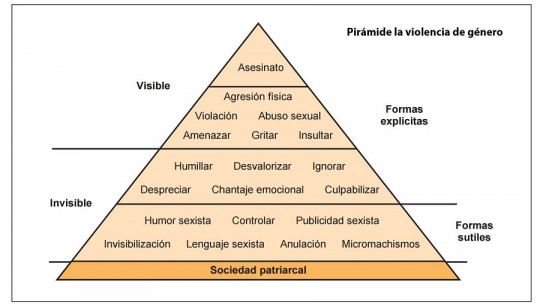Gender violence is a social scourge that persists despite the fact that in recent years it seems that visibility and awareness of it in the population has increased. Furthermore, the fact that among young people it is normalized and cases related to this type of violence in this age group are increasingly increasing, is alarming. Therefore, the prevention of gender violence from all sectors of the population is essential.
In this PsychologyFor article about how to prevent gender violence We address the keys to preventing this violence.
What is gender violence
According to the United Nations definition, gender violence is conceptualized as:
Any act of gender-based violence that results in, or may result in, physical, sexual or psychological harm to women, including threats of such acts, coercion or arbitrary deprivation of liberty, whether occurring in public life or in the private.
Gender violence is, therefore, violence against women for the simple fact of being a woman. Furthermore, it is not limited to the context of couple relationships, but occurs in different areas of life, such as political, social, work, etc.
Types of gender violence
This violence is a complex phenomenon that encompasses the following types of violence:
- Physical violence: the most visible type of violence and consists of any action that causes harm or suffering through physical aggression.
- Psychological violence: It is a violence that is more difficult to identify, since it is not as evident as physical violence. It includes humiliation, threats, coercion, manipulation, blaming, and also control and limitation.
- Sexual violence: any limitation or imposition on sexuality, as well as using force or coercion to carry out any sexual act against their will. Therefore, this violence includes, in addition to rape, unwanted touching, sexual harassment, trafficking in women or female genital mutilation, among others.
- Economic violence: deprivation of economic resources for women or discrimination in the provision of shared resources within the family. It is also considered economic violence if the aggressor prevents the woman from entering the labor market, forcing her to depend economically on him.
- Patrimonial violence: destruction or damage to objects and property of the victim with the aim of causing psychological harm and/or exercising domination over them.
- Symbolic violence: This violence is indirect and operates through gender roles and stereotypes, as well as messages and ideas that are internalized. These values reproduce, naturalize and maintain the situation of discrimination and oppression of women.
- Social violence: limitation and control with the aim of socially isolating the victim, distancing them from their close social circle. Humiliation and ridicule in social contexts are also included.
You can expand this information by consulting the article Types of gender violence: definition and its characteristics.

Causes of gender violence
To address the prevention of gender violence, first, we will briefly explain the causes of this violence.
The root of gender violence is patriarchal society, which is the social, political and economic structure that is based on the idea of superiority and domination of men over women. Therefore, sexist violence is a mechanism that seeks to reproduce and maintain the status quo of power relations of male domination in society.
The same patriarchal system assigns attributes, roles and spaces depending on whether you are a man or a woman. Based on this assignment, a differentiated socialization, in which the messages and teachings to men and women are different and are based on the predominant gender models in society. This socialization shapes our way of behaving, thinking and feeling.
How to prevent gender violence
The prevention of gender violence is based on the need to eradicate this type of violence, seeking measures and developing actions that prevent the appearance of gender violence. But how can we prevent gender violence? In the following sections, keys to the prevention of this violence are addressed from different areas or contexts.
How to prevent gender violence from school
The key to eradicating gender violence lies in socialization and education based on equality throughout the entire life cycle of the person, with special emphasis on childhood and adolescence so that models based on respect and equality are developed from an early age. This is why schools become one of the socializing agents of vital importance in coeducation or education in gender equality.
- It is necessary to work with the students with a transversal gender perspective it is not enough to only raise awareness about this problem on designated dates or days such as March 8 or November 25.
- With students, critical analysis and deconstruction of stereotypes and gender roles always adapting to the age of the class, as well as the development of skills for its detection, rejection and construction of identity based on other healthy and egalitarian models.
- Likewise, to prevent gender violence in adolescents, it is important to provide training in classrooms regarding signal detection and indicators of this violence, so that students become an element of prevention and elimination of gender violence both inside and outside the classroom.
- On the other hand, encourage Emotional education from schools with the aim of promoting the development of prosocial values such as empathy, as well as the non-violent resolution of conflicts from childhood, also facilitating gender prevention.
- Not only the students, but the entire educational center as a whole must be involved in the fight and prevention of this violence. The school itself must be an example of promoting equality and fighting against this violence, which is why it is essential training of teaching staff as positive references in gender matters. Both teachers and educational staff must raise awareness of gender equality, review their own attitudes and beliefs, and develop tools to address and prevent gender violence among students. This training favors the early detection of cases of violence, its prevention in the classroom and the promotion of values of respect and equality, as well as the effective application of an action protocol in situations of gender violence in the center.
- Finally, it is important review of educational materials of the school (books, songs, movies, etc.) to detect if they promote sexist stereotypes and roles, as well as the generation of new materials with a gender perspective and that promote equality.
In the following article, we address the topic of adolescents and gender violence in more detail.
How to prevent gender violence from the family
Another of the most important socializing agents in childhood is the family. This is why the transmission of values of equality and positive models from within the family is also essential.
- From the family, it is also important that adults carry out an exercise of critical reflection and review of educational attitudes and guidelines and parenting regarding gender equality at home.
- Likewise, it is necessary to transmit relationship models based on respect and equality and set an example of this type of relationship dynamic.
- In the case of a couple, it must be shown that parenting and domestic functioning are the responsibility of both and the tasks are distributed equally.
- On the other hand, attention must be paid and effort put into do not reinforce sexist roles and stereotypes at home, both in the couple and in parenting, promoting positive models of women and men that are not based on hegemonic masculinity and femininity, as well as promoting healthy couple relationship models and not based on myths of romantic love, since They favor relationships of dependency, control and extreme sacrifice for the emotional partner.
- The education between sisters and brothers should not differ based on sex, as well as the housework assigned to them.
- Likewise, communication and trust They are one of the bases of education, so it is important to talk about gender violence at home, as well as create an environment of trust so that sons or daughters can express any doubts or questions about this topic.
- From home it is important enhance empathy, respect and equality in a generic way, as well as strengthening the self-esteem of sons and daughters.
- Finally, to foster an environment of zero tolerance for violence, a peaceful conflict resolution model so that from childhood it is internalized as a reference and protocol for action in the face of any conflict by observing it and putting it into practice at home.

How to prevent gender violence from other contexts
Apart from the school and family environment, it is vitally important to involve the rest of the population and work from all sectors of society to prevent gender violence.
- A basic condition for this objective is an in-depth study of gender violence, its roots and the mechanisms through which it operates, since in order to effectively prevent any phenomenon, it is necessary know it globally This knowledge will allow the development of prevention actions based on theory and specifically aimed at the problem of gender violence.
- On the other hand, the rest of society must be informed about what this violence is and what types of violence it encompasses. Likewise, we must educate the idea that this violence not only occurs within the couple, but also in many others. In this way, through information and knowledge The early detection of cases of violence and the involvement of all sectors are encouraged, with the general population also becoming an active agent against this violence.
- The prevention and awareness campaigns They must put the focus of responsibility on the aggressor and not the victim, reinforce the idea of responsibility on the part of the rest of society and underline the importance of the involvement and action of the population in terms of preventing this violence.
- The media, leisure and culture should not promote gender roles, stereotypes or sexist messages, but rather show alternative models that serve as a reference, especially for children and youth.
- Likewise, we must end society’s permissiveness and tolerance with certain forms of gender violence, such as stereotypical representations of women, images of women as sexual objects, jokes that humiliate women, etc. To achieve this, the entire society must be aware of and committed to the fight against gender violence.
- It is essential to promote effective laws and policy measures regarding gender violence and their real application. It is necessary that people belonging to the political and judicial sphere have specific knowledge regarding gender violence to guarantee the effectiveness of political measures and laws.
- Apart from the legal and political sphere, gender training at work in general and, above all, in the social and health sectors is important.
- Finally, we must actively engage men and boys in awareness, participation and fight against gender violence. This commitment includes social non-tolerance of any type of violence against women. And, on the other hand, empower women, as active subjects, with voice and decision-making power in the approach against gender violence.
This article is merely informative, at PsychologyFor we do not have the power to make a diagnosis or recommend a treatment. We invite you to go to a psychologist to treat your particular case.
If you want to read more articles similar to How to prevent gender violence we recommend that you enter our Social Psychology category.
Bibliography
- Alonso Hernández, C., Cacho Sáez, R., González Ramos, I., Herrera Álvarez, E., & Ramírez García, J. (2016). Guide to good treatment and prevention of gender violence protocol for action in the educational field. Equality Plan Collection, (11), 1-158.
- United Nations (1993), Report of the Committee on the Elimination of Discrimination against Women.
- Pérez, JM; Montalvo, A. (2010). Gender violence: analysis and approach to its causes and consequences. Gender violence: prevention, detection and care. Group Publishing.








